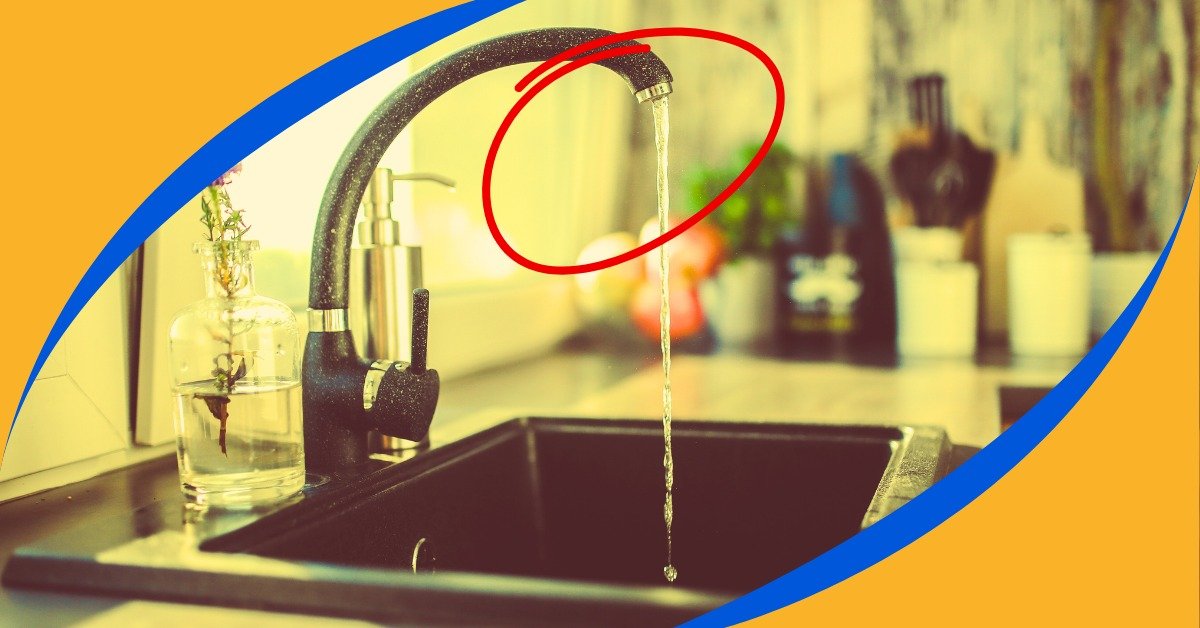Low water pressure in a house might seem like a small annoyance, but it can seriously disrupt daily routines. Whether you’re trying to take a shower, wash dishes, or water the garden, weak water flow turns basic tasks into frustrating chores.
For homeowners, low pressure isn’t just a comfort issue — it affects hygiene, appliance efficiency, and water usage. Slower washing machine cycles, underperforming water heaters, and longer cleaning times can all result from poor pressure.
In this guide, you’ll learn everything you need to diagnose and solve low water pressure issues:
- Common causes and how to spot them
- Step-by-step troubleshooting tips
- Long-term solutions for consistent pressure
- Smart ways to prevent future problems
Let’s dive in.
1. Common Causes of Low Water Pressure
Experiencing low water pressure can feel random — one minute your shower’s fine, the next it’s barely a trickle. But there are a handful of common culprits behind this issue:
Mineral Buildup in Pipes
Hard water contains minerals like calcium and magnesium that gradually accumulate inside pipes. Over time, these deposits restrict water flow, lowering pressure at faucets and showers.
Corroded or Aging Plumbing
Homes with older plumbing (especially galvanized steel or iron pipes) often suffer from internal corrosion. This rust buildup narrows the pipe openings, leading to decreased water pressure throughout the home.
Faulty Fixtures (Aerators, Showerheads, Valves)
Sometimes the issue is right at the end of the line. Clogged faucet aerators or showerheads can drastically reduce water flow. If only one fixture has poor pressure, it’s likely a local issue — not the whole system.
Municipal Water Supply Issues
Pressure problems may not start inside your home. Municipal supply lines can drop pressure during peak usage times, maintenance work, or due to hidden leaks. Nearby construction or neighborhood-wide outages can also affect your home’s water flow.
While municipal supply issues are common, many homeowners and businesses opt for independent water sources to ensure consistent pressure and availability. Private well systems, for instance, offer a reliable alternative, especially in areas where public water pressure is inherently low or unreliable. The initial step often involves specialized processes like deep well drilling to tap into stable underground aquifers. Ensuring professional installation and regular maintenance of these well and pump systems is crucial for a dependable and high-pressure water supply for years to come.
Elevation and Gravity
If your home sits on a hill or is located at a higher elevation, water may lose pressure as it travels uphill. This gravity-related drop can result in consistently weaker flow unless boosted by additional pressure systems.
How to Identify the Signs of Low Water Pressure
Not sure if your pressure problem is real or just temporary? Watch for these clear signs of low water pressure:
Weak Stream from Taps and Showers
If your faucets or showerheads produce only a thin stream instead of a strong, steady flow, your plumbing system may be struggling with pressure loss.
Slow-Filling Appliances
Appliances like dishwashers and washing machines that take unusually long to fill could be affected by reduced water pressure, especially if this happens across multiple machines.
Fluctuating Water Flow
If your water pressure surges or drops while using a tap or shower, it often points to clogged pipes, pressure valve issues, or inconsistent flow from the main line.
Noisy or Banging Pipes
Hearing banging or knocking sounds (known as “water hammer”) can mean trapped air or uneven pressure in your system. It’s often a symptom of larger plumbing issues.
Step-by-Step Troubleshooting Guide
Once you’ve confirmed signs of low pressure, use this checklist to pinpoint the cause:
Check the Main Shut-Off Valve
Locate your home’s main water valve (usually near the meter or basement entry) and ensure it’s fully open. A partially closed valve can significantly limit water flow.
Test Multiple Fixtures
Determine whether the issue is isolated or widespread. If only one fixture has low pressure, the problem likely lies in the fixture itself — not the entire system.
Inspect for Leaks or Water Damage
Leaks can silently lower pressure across your home. Look for water stains, dripping sounds, or mold around sinks, ceilings, and walls — especially in basements or utility closets.
Examine the Pressure Regulator or Water Meter
If your home has a pressure regulator, check that it’s working properly. Faulty regulators can cause sudden drops. Your water meter may also indicate if the problem lies at the main supply line level.
Long-Term Solutions to Fix Low Water Pressure
If you’ve identified the root cause of low water pressure, temporary fixes may not be enough. Here are long-term strategies to restore and maintain consistent water flow:
Flush Out or Replace Old Pipes
If buildup or corrosion is choking your plumbing system, flushing the pipes might help — especially if the issue is minor. For homes with older, heavily corroded plumbing, pipe replacement (re-piping) may be the most effective solution.
Upgrade Plumbing Fixtures
Modern low-flow fixtures are designed to conserve water without sacrificing pressure. Replacing outdated faucets, showerheads, or pressure-balancing valves can significantly improve flow while maintaining efficiency.
Install a Water Pressure Booster Pump
In cases where municipal supply or elevation causes permanent low pressure, a booster pump can solve the issue. These devices increase water pressure at the point it enters your home and are ideal for multistory or hillside homes.
Repair or Replace Faulty Pressure Regulators
A worn-out pressure regulator can prevent water from reaching optimal pressure. Replacing it with a professionally calibrated unit ensures your entire plumbing system receives balanced, reliable flow.
Preventing Low Water Pressure in the Future
Prevention is often easier and cheaper than repair. These best practices will help you avoid pressure problems before they start:
Schedule Regular Plumbing Inspections
Annual checkups from a licensed plumber can catch early signs of buildup, corrosion, or valve issues. Early detection keeps your water flow steady and prevents costly breakdowns later.
Clean Faucet Aerators and Showerheads
Over time, mineral particles can clog these small openings. Unscrew and soak them in vinegar every few months to dissolve limescale and keep flow strong.
Monitor Household Water Usage
Running multiple high-demand appliances (like a dishwasher and washing machine) at once can temporarily lower pressure. Try staggering their use during off-peak hours to balance flow.
Install a Whole-House Water Softener (if needed)
In hard water areas, a softener helps reduce mineral buildup in pipes and appliances. This can prolong your plumbing’s lifespan and preserve water pressure long-term.
When to Call a Professional Plumber
While many water pressure issues can be handled with basic tools and troubleshooting, there are times when it’s best to bring in an expert. Here’s when to call a licensed plumber:
Pressure Drops Suddenly Across the Whole House
A sharp, unexpected loss in pressure could signal a main line break or a failing pressure regulator. These issues require immediate professional inspection.
Recurring or Worsening Pressure Problems
If you’ve tried DIY fixes but the issue keeps returning, there may be a deeper issue — such as a hidden leak, partially collapsed pipe, or undersized supply line.
Signs of Water Damage or Mold
Wet spots on walls, ceilings, or flooring could indicate pipe leaks that are lowering your pressure. Left unaddressed, this could lead to expensive structural repairs.
You’re Planning a System Upgrade
If you’re adding new bathrooms, outdoor spigots, or a sprinkler system, it’s smart to evaluate whether your existing system can handle the increased demand. A plumber can help assess your current capacity and recommend improvements.
Installing a Pressure Booster Pump
When gravity or low municipal supply is limiting your water flow, a pressure booster pump can make all the difference. This mechanical device increases water pressure by adding force as it enters your home, helping to deliver a stronger and more consistent flow to all fixtures.
How It Works
A booster pump draws water from the main line and pressurizes it using an electric motor and impeller system. It then distributes this pressurized water through your home’s plumbing network. Some systems also include a pressure tank to maintain steady flow and reduce pump cycling.
Ideal Use Cases
Booster pumps are especially useful in:
- Homes on high ground or hillsides
- Multi-story houses with weak upper-floor pressure
- Properties at the end of a municipal line
- Homes using private wells with variable pressure
Things to Consider Before Installation
Installing a booster pump isn’t always a plug-and-play solution. You’ll need to:
- Check local plumbing codes (some require a permit)
- Ensure your pipes can handle increased pressure
- Choose the right pump size and type for your water needs
- Consider combining with a pressure tank for optimal efficiency
Professional installation is highly recommended, especially to avoid over-pressurizing your system — which can damage pipes and fixtures.
Conclusion
Low water pressure might feel like a minor nuisance at first, but as we’ve seen, it often points to larger issues hiding in your plumbing system. Fortunately, most pressure problems are detectable, manageable, and fixable — especially once you understand the possible causes and solutions.
Key Takeaways
- Low pressure is often due to buildup, faulty fixtures, or supply limitations
- Simple troubleshooting can identify isolated versus system-wide issues
- Long-term solutions like re-piping, updated fixtures, or booster pumps are available
- Regular maintenance and smart prevention go a long way
You’re Not Alone — And You’re Not Stuck
Whether you choose a DIY route or call in a professional, remember: you’re not powerless. A consistent, steady water flow is achievable — and often easier to restore than you think.
Take the first step: check your valves, test your fixtures, and observe your water flow. From there, you’ll know exactly what to fix — and how.
FAQs: Common Questions About Low Water Pressure
Q: Is low water pressure dangerous or just annoying?
While not dangerous in most cases, low pressure can indicate leaks, corrosion, or aging pipes — all of which may lead to bigger issues (including water damage) if left unchecked.
Q: Can water pressure be too high?
Yes. Pressure above 80 PSI can strain pipes and appliances, increasing the risk of bursts or leaks. If your pressure seems unusually strong, it’s wise to test it and consider a pressure-reducing valve.
Q: Does low pressure affect hot and cold water equally?
It depends on the cause. If only hot water has low pressure, your water heater or its pipes may be the issue. If both are weak, the problem is likely in the main supply or shared plumbing lines.
Q: Will replacing my showerhead improve water pressure?
It can — especially if the old one is clogged or inefficient. A high-efficiency or pressure-boosting model may improve flow noticeably, even without changing the plumbing.
Q: Can hard water lower water pressure over time?
Yes. Mineral-rich water leads to buildup inside pipes and fixtures, which restricts flow and gradually reduces pressure. A water softener can help prevent this problem long-term.

Alex Taylor is a seasoned writer and editor with over 5 years in digital media, specializing in practical home maintenance guides and homeowner tips. From heating system upkeep to seasonal repair checklists, Alex blends clear, relatable advice with real-world experience to help readers protect their homes and budgets. He personally reviews and fact-checks every article in his areas of expertise to ensure accuracy, clarity, and real-world usefulness. His work also spans tech, culture, fashion, sports, and lifestyle—always with a focus on clarity, relevance, and reader value.
Discover more from Try Hard Guides
Subscribe to get the latest posts sent to your email.

